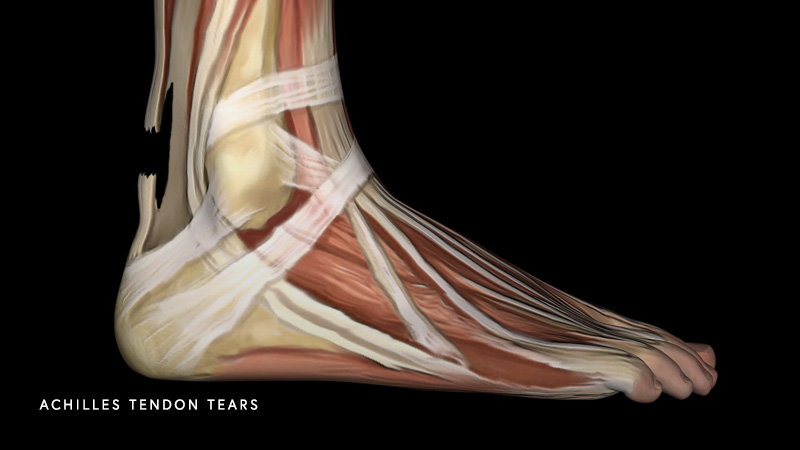Achilles Tendon Tears and Tendonitis
The Achilles tendon is the largest and strongest tendon in the human body, and the most frequently torn. It connects the calf muscle to the heel bone. We use it when we walk, run, climb, jump and stand on our tiptoes! Multiple factors contribute to tendon disease including exercise, overuse, genetic predisposition and aging. In general men are more likely than women to suffer an Achilles tendon disorder.
Achilles tendon disorders include tendinitis and rupture. Both are a frequent cause of pain and disability in athletes and non-athletes alike.
- Sudden forceful stress on the calf muscles from athletics
- Running uphill
- Running on a hard surface
- Pushing off on the ball of the foot with force as seen in basketball, tennis and football.
- Sprinting that requires a quick start and stop
- Falling off a ladder or height
- Stepping into a hole
Men ages 25 – 45 are more likely to suffer an Achilles tendon rupture than women. High energy sports are responsible for acute tears in young men while low energy injuries, and degenerated tendons typically cause tears in people over the age of 60. Underlying medical conditions such as thyroid disease, rheumatoid arthritis, diabetes and obesity increase the risk of rupture. Other risk factors include poor conditioning, oral or injected steroids, use of some antibiotics and overuse.
A partial tear may cause no or only mild symptoms. A complete tear is painful and affects strength and movement. Other symptoms include:
- A sudden, sharp pain in the heel/back of the ankle
- A popping sound or sensation
- A feeling that someone kicked your ankle
- Limping, pain during running and jumping
- Swelling and bruising and the inability to point the foot downward or stand on tiptoes.
It is diagnosed by signs and symptoms and physical exam. Ultrasound and MRI are useful to assist in diagnosis.
It is diagnosed by signs and symptoms and physical exam. Ultrasound and MRI are useful to assist in diagnosis.
It can be successfully treated without surgery with conservative measures that include NSAIDS for pain, rest, icing, compression, elevation, stretching, rehabilitative exercises, orthotics, bracing, injection therapy, shock wave therapy and low-level laser therapy. Special training exercises can help prevent Achilles tendinitis. When pain fails to improve after six months of conservative measures surgery may be recommended.
Recommended treatment depend on the patient’s age, activity level and severity of the injury. Conservative treatment involves RICE, OTC pain medication, casting or wearing a boot for 8-12 weeks followed by physical therapy. Nonsurgical treatment is often adequate to treat acute tears in young patients with an acute sports injury. Non-surgical treatment provides good functional outcome and high patient satisfaction but may create a risk of re- rupture.
However, outpatient surgery is often recommended for young to middle aged active patients. The procedure involves sewing the torn ends of the tendon back together. After surgery the patient will wear cast or walking boot, and after treatment rehabilitation to restore strength, stability and mobility are essential. Complete healing takes 4-6 months but return to play can take up to a year.
Contact the orthopaedic authorities at the Center for Orthopaedic Specialists to schedule a consultation to learn more. we have offices in Santa Clarita, Westlake Village, Tarzana and Mission Hills California for your convenience. We also offer virtual visits.



 / 50 Reviews
/ 50 Reviews